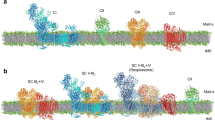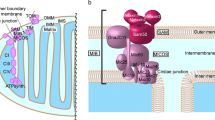Abstract
MRS6 is a newly-identified gene in the yeast Saccharomyces cerevisiae. Its product Mrs6p shows significant homology to the mammalian GDP dissociation inhibitor (GDI) of Rab/Ypt-type small G proteins and to the human choroideraemia protein (CHM), the component A of Rab-specific GGTase II. The interaction of Mrs6p with G proteins is indicated by our observation that the MRS6 gene suppresses the effect of a temperature-sensitive ypt1 mutation. Disruption of the MRS6 gene is lethal to haploid yeast cells. This is consistent with the notion that Mrs6p is interacting with Rab/Ypt-type small G proteins, which are known to have essential functions in vesicular transport. Unexpeciedly, the MRS6 gene product also affects mitochondrial functions as revealed by the facts that highcopy numbers of MRS6 (1) suppress the pet - phenotype of mrs2-1 mutant strains and (2) cause a weak pet - phenotype in wild-type strains. We conclude from these results that the MRS6 gene product has a vital function in connection with Rab/Ypt-type proteins in the cytoplasm and, in addition, affects mitochondrial functions.
Similar content being viewed by others
References
Andres DA, Seabra MS, Armstrong SA, Smeland TE, Cremers FPM, Goldstein JL (1993) Cell 73:1091–1099
Araki S, Kaibuchi K, Sasaki T, Hata Y, Takai Y (1991) Mol Cell Biol 11:1438–1447
Baker KP, Schatz G (1991) Nature 349:205–208
Becker J, Tan TJ, Trepte HH, Gallwitz D (1991) EMBO J 10:785–792
Boguski MS, McCormick F (1993) Nature 366:643–654
Bussereau F, Dupont CH, Boy-Marcotte E, Maller L, Jacquet M (1992) Curr Genet 21:325–329
Caplan AJ, Cyr DM, Douglas MG (1992) Cell 71:1143–1155
Cox AD, Der CJ (1992) Curr Opin Cell Biol 4:1008–1016
Dunn B, Stearns T, Botstein D (1993) Nature 362:563–565
Fodor E, Lee RT, O'Donnel JJ (1991) Nature 351:614
Fujimura K, Tanaka K, Nakano A, Toh-e A (1994) J Biol Chem 269:9205–9212
Harshman KD, Moye-Rowley WS, Parker CS (1988) Cell 53: 321–330
Jiang Y, Rossi G, Ferro-Novick S (1993) Nature 366:84–86
Kaziro Y, Itoh H, Kozasa T, Nakafuku M, Sato HT (1991) Annu Rev Biochem 60:349–400
Li R, Havel C, Watson JA, Murray AW (1993) Nature 366:82–84
Lithgow T, Timms M, Hoj PB, Hoogenraad NJ (1991) Biochem Biophys Res Commun 180:1453–1459
Magee T, Newman C (1992) Trends Cell Biol 2:318–323
Molenaar CMT, Prange R, Galwitz D (1988) EMBO J 7:971–976
Musha T, Kawata M, Takai Y (1992) J Biol Chem 263:4509–4511
Salminen A, Novick P (1987) Cell 49:527–538
Sasaki T, Kaibuchi K, Kabcenell AK, Novick PJ, Takai Y (1991) Mol Cell Biol 11:2909–2912
Schmitt HD, Wagner P, Pfaff E, Gallwitz D (1986) Cell 47:401–412
Schmitt HD, Puzicha M, Gallwitz D (1988) Cell 53:635–647
Schnell N, Krems B, Entian KH (1992) Curr Genet 21:269–273
Seabra MC, Goldstein JL, Südhof TC, Brown MS (1992a) J Biol Chem 267:14497–14503
Seabra MC, Brown MS, Slaughter CA, Südhof TC, Goldstein JL (1992b) Cell 70:1049–1057
Segev Y, Mulholland J, Botstein D (1988) Cell 52:915–924
Sztul ES, Melancon P, Howell KE (1992) Trends Cell Biol 2:381–386
Takai Y, Kaibuchi K, Kikuchi A, Kawata M (1992) Int Rev Cyt 133:187–231
Waldherr M, Ragnini A, Schweyen RJ, Boguski MS (1993a) Nature Genet 3:193–194
Waldherr M, Ragnini A, Jank B, Teply R, Wiesenberger G, Schweyen RJ (1993b) Curr Genet 24:301–306
Walworth C, Goud B, Kabcenell AK, Novick P (1989) EMBO J 8:1685–1693
Wiesenberger G, Link TA, von Ahsen U, Waldherr M, Schweyen RJ (1990) J Mol Biol 217:23–37
Wiesenberger G, Waldherr M, Schweyen RJ (1992) J Biol Chem 267:6963–6969
Author information
Authors and Affiliations
Additional information
Communicated by L.A. Grivell
Rights and permissions
About this article
Cite this article
Ragnini, A., Teply, R., Waldherr, M. et al. The yeast protein Mrs6p, a homologue of the rabGDI and human choroideraemia proteins, affects cytoplasmic and mitochondrial functions. Curr Genet 26, 308–314 (1994). https://doi.org/10.1007/BF00310494
Received:
Accepted:
Issue Date:
DOI: https://doi.org/10.1007/BF00310494




